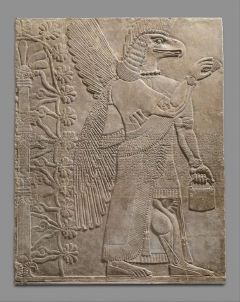All entries for Sunday 28 March 2021
March 28, 2021
The Monarchy and Magic at Nimrud, by Emily Porter–Elliot
 |
Relief panel from Nimrud, Iraq. (229.9 x 187 x 5.7 cm), Metropolitan Museum of Art No. 31.72.3. OA Public Domain. |
This relief panel is from Northwest Palace at Nimrud, which is situated in modern day Iraq. Nimrud was a monumental site of various palaces and temples, with the most magnificent and perhaps the best understood archaeological remains, being that of the Northwest Palace, built by Ashurbanipal II (883-859 BC). The palace was decorated with an elaborate series of reliefs which boasted of the achievements and power of the Assyrian state. The panel was originally acquired by H. C. Rawlinson who gifted it to William Frederick Williams in 1854. The panel eventually ended up in the care of Union College, who sold it to C.E. Wells for J.D. Rockefeller. It was eventually gifted to the Metropolitan Museum of Art in New York in 1931 by J.D. Rockefeller, where it is now on display along with other Assyrian antiquities in Gallery 401.
The panel portrays a winged supernatural figure, which faces left, and has the head of an eagle with a male human body. These figures appear throughout the palace in a series of reliefs which were originally painted in vivid colours, but these pigments have sadly not survived. The figures are representative of the supernatural population rather than representing divine beings and are slightly different in form with some being human-headed and others eagle-headed figures. They appeared in the doorways and in close proximity to the throne room. Figurines were commonly buried under doorways for protection in this period and had some similarities to the ones in the Northwest Palace relief scenes. The figures, therefore, have complex meaning and significance and there has been much speculation about the symbolism contained within the relief series.
What the figure holds has been highly contested. The object in its right hand has been thought to be a purifier, but others have argued that it is in fact a bucket. The object in the left hand has proved more puzzling but is thought to be a cone, representative of a special implement used by Mesopotamian farmers in a ritual action whereby the date-palm tree was fertilised. This tree is thought to be representative of prosperity and alludes to the idea of protecting the Assyrian state. The figures’ presence within the palace hints at the extent to which the king has gone to ensure the state is protected. The figure is elaborately dressed and bedecked in jewellery which makes references to divinity and was ostentatious in its design.
These relief panels are unique in that they contain an inscription which cuts across the imagery. This inscription runs throughout the entire relief series, often in the middle of the image. The inscription was in cuneiform script and written in Akkadian, although it is unlikely that many people who frequented the palace would have been able to actually read the inscription, they would have been aware of its significant and powerful presence. The inscription details the achievements of Ashurbanipal II, and discusses the heritage and royal titles of Ashurbanipal, before detailing his extensive military and building campaigns. It has been suggested the inscription was also used in the palatial decoration, as it had magical connotations and contributed to the protection of the palace, king and more widely the Assyrian state.
Bibliography:
Cline, E. and Graham, M.W. (2011) Ancient Empires from Mesopotamia to the Rise of Islam. Cambridge: Cambridge University Press.
Crawford, V.E and Harper, P. O and Pittman, H. (1980) Assyrian Reliefs and Ivories in the Metropolitan Museum of Art: Palace Reliefs of Assurnasirpal II and Ivory Carvings from Nimrud. New York: Metropolitan Museum of Art.
Metropolitan Museum of Art. Relief Panel- https://www.metmuseum.org/art/collection/search/322595 (2021) Accessed 14th March 2021.
Seymour, M. Nimrud- https://www.metmuseum.org/toah/hd/nimr_1/hd_nimr_1.htm (November 2016) Accessed 14th March 2021.
 |
This post was written by Emily Porter-Elliot, who is currently studying for an MA in Ancient Visual and Material Culture at the University of Warwick. Emily did her undergraduate studies in Archaeology at Cardiff University. Emily’s research interests are in museums and their collection histories and is especially interested in how museums sometimes controversially display artefacts. |



 Please wait - comments are loading
Please wait - comments are loading
 Loading…
Loading…

